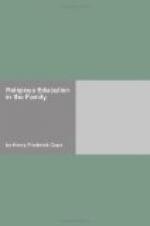The religious life of the child is essentially a matter of loyalty. His faith, affections, aspirations, and endeavors turn toward persons, institutions, and concepts which are to him ideal. He does not analyze, he cannot describe, or even narrate, his religious experiences, but he affectionately moves, with a sense of pleasure, toward those things which seem to him ideal, toward parents, customs of the home or school, the church, his class, his teacher, toward characters in story-books. He is likely to think of Jesus in just that way, as the one person whom he would most of all like to know and be with. The life of virtue and the religious life then will be weak or strong in the measure that the child has the stimulating ideals which call forth his loyalty and in the measure that he has opportunity to express that loyalty. His religious life will consist, not so much in external forms perhaps, still less in intellectual statements about theology or even about his own experiences, as in a growing realization of the great ideals, an increasing sense of their meaning and reality within, and, on the objective side, a steady moving of his life toward them in action and habits and therefore in character and quality.
Sec. 7. IMPORTANT CONSIDERATIONS
It is worth while to insist upon two important considerations. Parents who stand as gardeners watching the growth of the tender plant of child-character may be looking for developments that never ought to come and will be disappointed because they were looking for the wrong thing. First, in watching for the beginnings of the religious life of the child in the family we are not expecting some new addition to the life, but rather the development of this whole life as a unity in a definite direction which we call religious. It is the first and most important consideration that religious education is not something added to the life as an extra subject of interest, but the development of the whole life into religious character and usefulness. Secondly, this growth of religious character is going on all the time. It is not separable into pious periods; it is a part of the very life of the family. Perhaps this increases the difficulty of our task, for it removes it from the realm of the mechanical, from that which is easily apprehended and estimated. It takes the task of the religious education of children out of the statistical into the vital, and reminds us that we are growing life every second, that there is never a moment when religious education is not in operation. This demands a consideration, not alone of lessons, of periods of worship and instruction, but of every influence, activity, and agency in all the family life that in any way affects the thinking, feeling, and action of the child. We are thinking of something more important than organizing instruction and exercises in religion in the home; we are thinking of organizing the family life for religious purposes, for the purpose of growing lives into their spiritual fulness.




